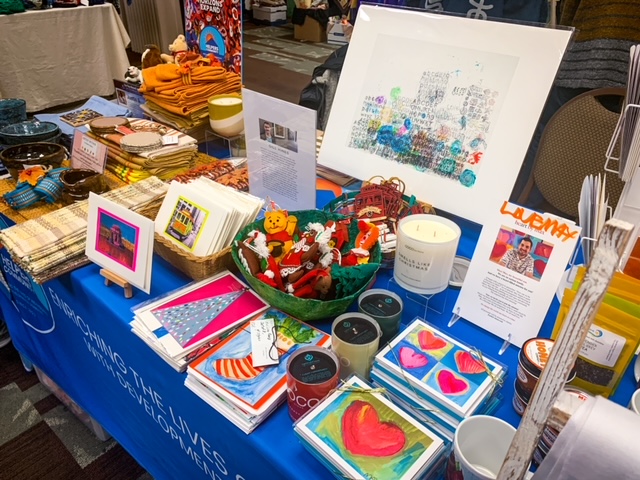By Jack Quoch
Waiting for the de Young Museum’s annual Holiday Textile Bazaar to open its doors on the morning of Nov. 12, patrons in line shared conversations of anticipation. Some were excited to return and find the best deals for handmade crafts and clothing. Others looked forward to browsing through the colorfully ornate tables for the first time. Others shared that they were experiencing the role of shopper after years of being vendors.
The bazaar, presented by the de Young Museum Textile Arts Council, brought artisans and vendors from across the Bay Area together in the St. Mary’s Cathedral Event Center. The event featured free admission for all attendants. Vibrant jewelry, fabrics, and accessories decorated the vendors’ tables, forming intricately lined pathways that customers explored.
Helpers Community Inc., a nonprofit organization, hosted a table with handmade Christmas cards, ornaments, vintage Holiday dolls, mugs and an assortment of home decorations.

The nonprofit, located on Fulton Street, seeks to promote wellness and rehabilitation for those with disabilities and special needs. Helpers Community collaborates with local organizations to engage in art creation. At the Holiday Textile Bazaar, they displayed small posters next to the items. These posters shared the names and stories of the artists who belonged to the communities connected with the nonprofit.
Founded in 1953, Helpers Community has served in Bay Area communities to encourage greater involvement in the arts – the vintage dolls originated in the 1960s. Marilyn Harrison, the retail marketing director for the organization, greeted passersby to share about the group’s mission.
“I work with all of the different artists in the organizations because I really feel like we want to be a voice for artists with developmental disabilities,” she said.
After connecting with lead directors within the Textile Arts Council, Harrison and Helpers Community joined the textile bazaar for the first time in November. The experience inspired confidence about the inclusion of different abilities in the space of art and creativity.

“I’m thrilled to be here,” Harrison said. “My hope is that there is more awareness about the talent that individuals with developmental disabilities have.”
Along with a variety of cities in the Bay Area, the bazaar spotlighted artwork from a diversity of ethnic regions and cultures. One such stand was Art by YJ, which featured South Asian designs created by Singaporean artist Vyjayanthi Malladi. Malladi uses a technique called batik, a design which incorporates wax dyeing onto cloth. It also is a highly meticulous skill usually taught to selective populations.
Sharing the pieces of art through the holiday bazaar represented a way of “teaching the younger generation of artists, who are going to be preserving this culture,” said Maryam Khawar, an intern at the business and current student at UC Berkeley. She added that in the artist’s first year living in the Bay Area, connecting with the de Young Museum proved to be an “amazing experience.”
Many vendors featured a collection made and curated by an artist. Peggy Osterkamp, an artist centered in Fort Mason, displayed detailed patterns and jewelry, which caught the attention of strollers and dedicated shoppers. Osterkamp, who formerly taught at City College, said she gained a love for weaving by combining her passion for teaching and eagerness to learn a new skill.
Similarly, Dianne Boate enjoyed using the presence of the Holiday Textile Bazaar as an outlet for her creative interests in painting, photography and crafting. She added that her business gave her a way of interacting with her neighborhood after recovering from health issues that prevented much social interaction.
Throughout the walkways created by the lined tables, shoppers held up clothing pieces to each other, tried on hats in front of mirrors, and engaged in conversation with vendors. A sense of appreciation for the artistry and craftsmanship flowed throughout.
Categories: Art












2 replies »